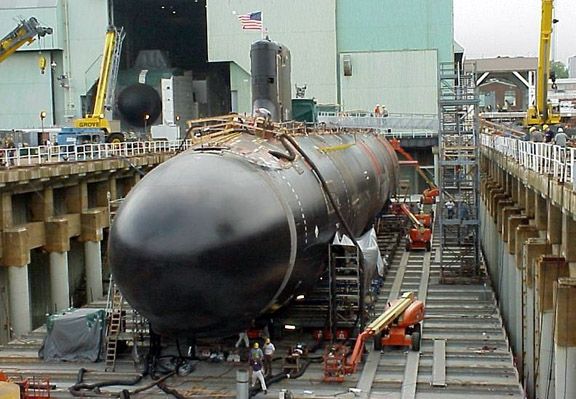
The U.S. Navy submarine force structure calls for 66 SSN attack submarines (all classes) with a remote possibility of up to 72 SSNs. The projected Virginia class production run was originally planned for 66 but may likely top out at 52 (maybe 57 if the sale to Australia for up to five Virginia class submarines goes through) for the time being. The 14 remaining boats (to meet the 66 SSN attack submarine total) will likely be made up of surviving Improved Los Angeles class (SSN 688I) submarines, which will eventually be replaced by the Improved Virginia/SSN(X) class next-generation attack submarine still under design.
In reality, such a successor submarine may be a long time coming. The first effect of the U.S. Navy increase in force structure was that the number of Block V submarines optimized for cruise missile attack to be built was set at 10. They would be followed by six Block VI submarines that will also be equipped with the Virginia Payload Module (VPM). This would lead to the probability that the last round of submarines might be of a “Block VII” configuration.
However, the continued procurement of Virginia class submarines and VPM modules will likely take place against financial pressure from the Columbia class program. Originally, the plan was to drop procurement of SSN 774 Virginia class submarines from two per year to one for years in which a Columbia class SSBN was ordered. However, the U.S. Navy is strongly in favor of maintaining the SSN 774 Virginia class production rate at two per year and has received significant support for this position from key groups, including the Joint Requirements Oversight Council. This support was strong enough to create pressure for a further increase to three hulls in the FY20 budget, adding an additional submarine to the Block V total. The key to this discussion is the ability of the submarine construction infrastructure to handle the production of three boats per year. If this proves to be viable, it is possible that the Virginia class construction program will be significantly enlarged and accelerated.
A U.S. Navy study of the submarine construction infrastructure has concluded that tentative plans for the production of two Virginia class SSNs and a Columbia class SSBN per year for 12 years are viable assuming that the funding necessary for a program of this scale can be made available. By that time, the newest of the Improved Los Angeles class SSN 688s will be 40 years old and overdue for replacement. This factor would strongly suggest that a decision to maintain production at a minimum of two SSNs per year will be made.
The Block V construction has been met with delays and according to a report from the U.S. GAO, the program continues to degrade with supply chain issues, workforce shortages, and limited shipyard capacity — all of this making it difficult for the U.S. Navy to maintain its schedule of producing to submarines a year.
Throw into the mix the AUKUS plan for the U.S. to sell three Virginia class submarines for operational deployment in the early 2030s (with an option to buy two more for a total of five submarines) and the U.S. will be extremely hard-pressed to meet its own force requirements.
While such a sale will have to have the approval of the U.S. Congress, Australia’s fielding of Virginia class submarines as soon as possible would provide a stopgap until Australia begins fielding its own SSN-AUKUS submarines planned to be operational in the early 2040s.
The latest plan floating around is for the U.S. to transfer two of its current Virginia class submarines (probably Block III or IV) to Australia with the third to come off the current production line. Although not officially set in stone, this is likely the best solution to fill the capability gap between Australia’s current Collins class diesel-electric submarines coming to the end of their life and until the SSN-AUKUS submarines are ready.
An examination of the construction rates suggests that the lockdowns and quarantines resulting from the COVID-19 pandemic have had some impact on Virginia class construction rates despite the exemptions granted because of its strategic importance.
It is unlikely that the SSN construction rate will accelerate beyond two boats per year even if the Australia procurement is approved, although the addition of the SSBN construction program would already take the total number of submarines ordered in those years to three. It could be argued that the aging state of the remaining Improved Los Angeles class submarines would make an increase to three SSNs per year desirable, with the third taking the place of the Columbia class SSBNs once the 12 planned submarines of that type have been funded. However, this proposition is highly speculative.
For more than 30 years, Richard has performed numerous roles as a top analyst for Forecast International. Currently, Richard is the Group Leader and Lead Analyst for Forecast International's Traditional Defense Systems, which covers all aspects of naval warfare, military vehicles, ordnance and munitions, missiles, and unmanned vehicles.
Having previously been Forecast International's Electronics Group Leader for 20-plus years, Richard established Electro-Optical Systems Forecast, as well as having been the prime editor of Electronic Systems Forecast, Land & Sea-Based Electronics Forecast, and C4I Forecast. Additionally, Richard has served as the Naval Systems Group Leader responsible for Anti-Submarine Warfare Forecast andWarships Forecast.



